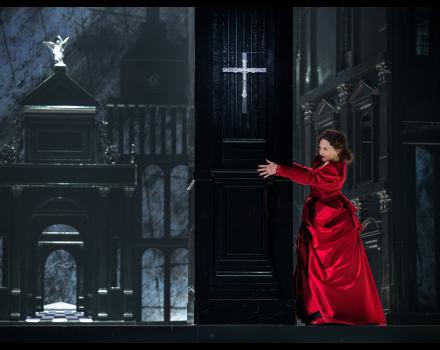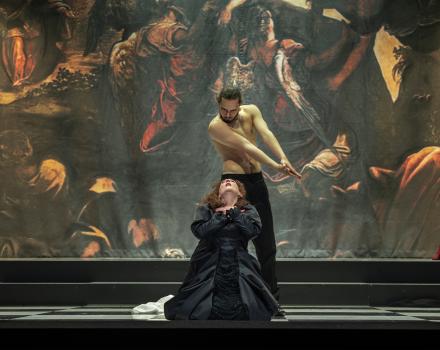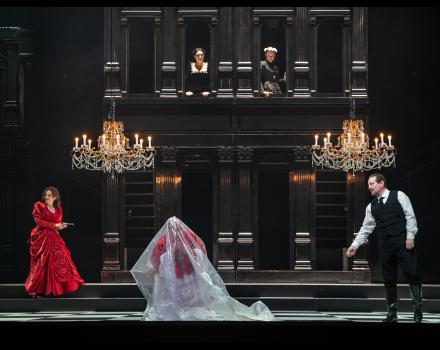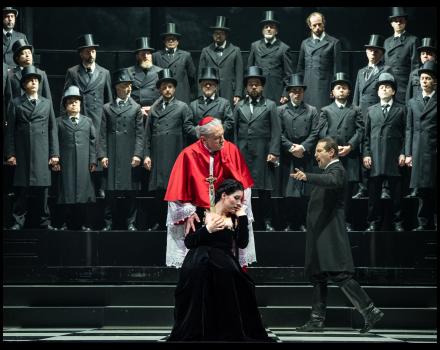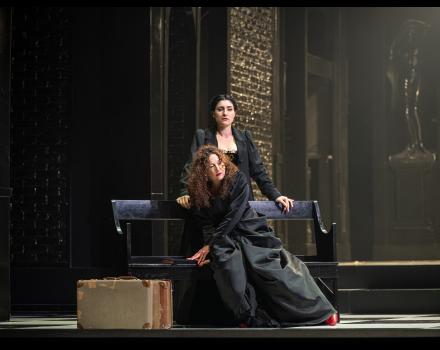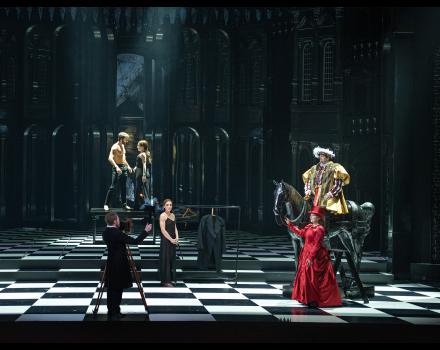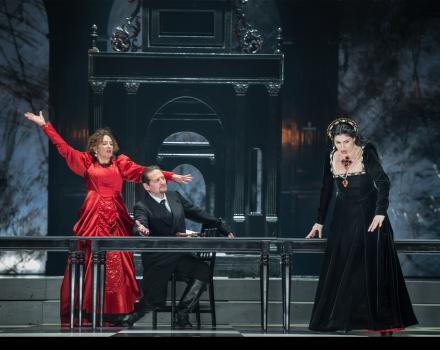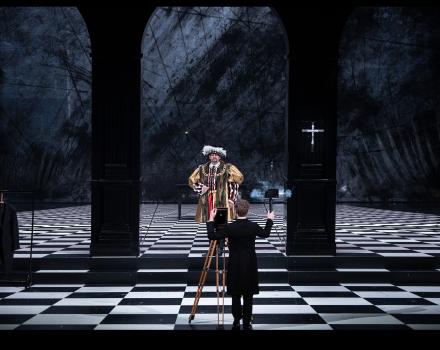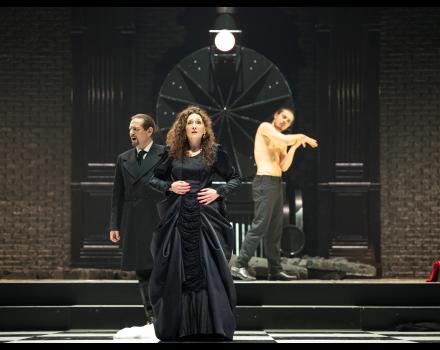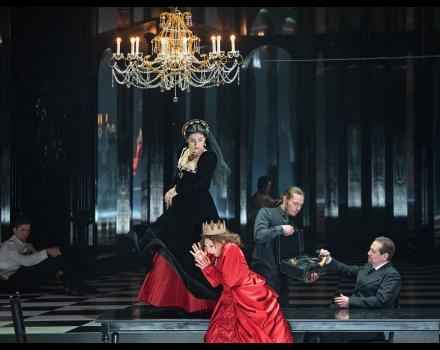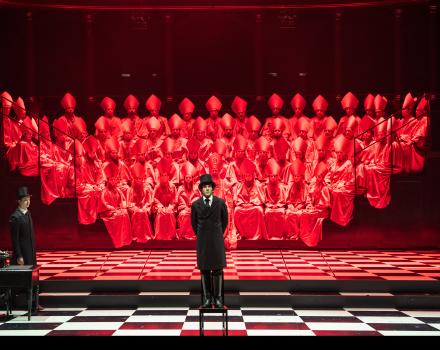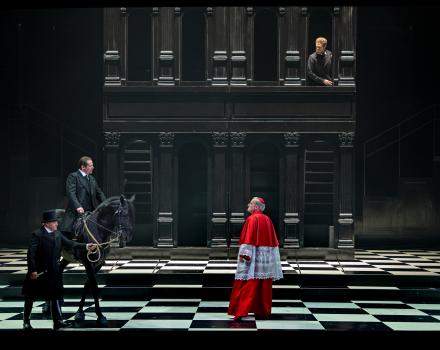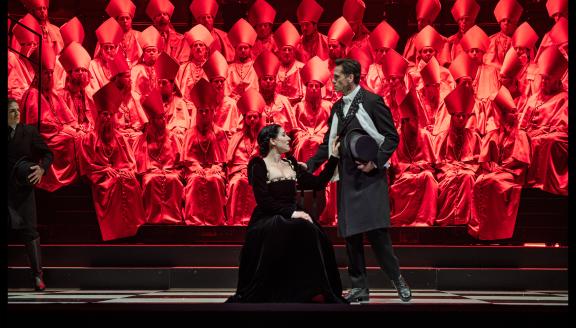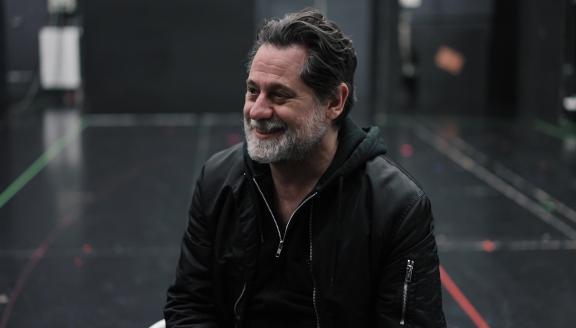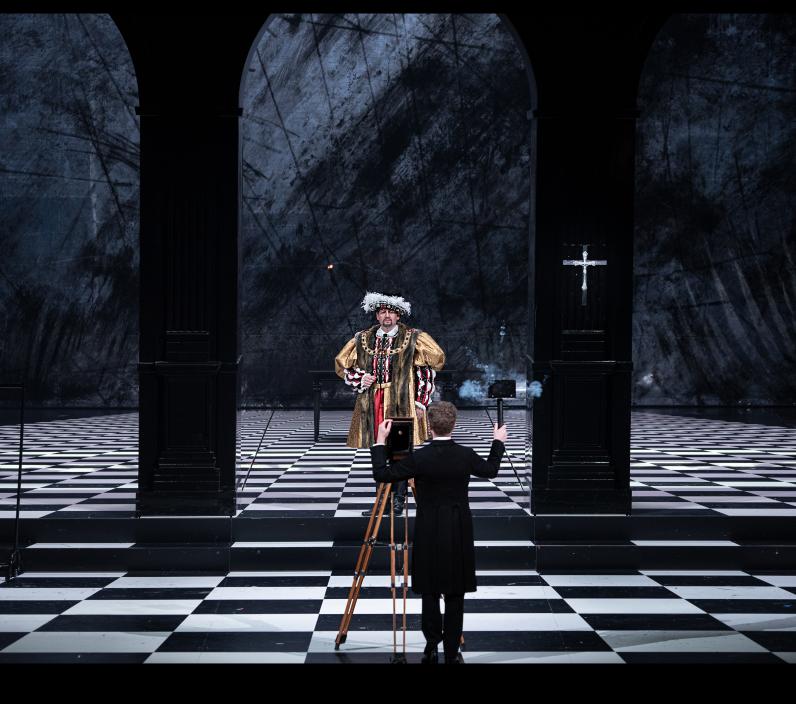
Six marriages, two annulments, two beheadings and the founding of his own Church, against the authority of Rome... in his search for a suitable spouse, the notorious Tudor King of England Henry VIII shrank from nothing. Here we focus on the amorous and political intrigues surrounding the annulment of Henry's first marriage to Catherine of Aragon in favour of his new passion for Anne Boleyn.
Henry VIII, a grand historical opera by Camille Saint-Saëns, is characterised by stark contrasts: ardour and modesty, jealousy and renunciation, intimacy and solemnity. La Monnaie in Brussels have entrusted their new production to director Olivier Py and conductor Alain Altinoglu, two fervent champions of the French repertoire. With magnificent sets, high drama and compelling music, this production offers a musical journey which starts in sixteenth century England but still resonates today through a timeless question: How far can a man of power go with his conquests?
CAST
|
Henry VIII
|
Lionel Lhote
|
|---|---|
|
Don Gomez de Féria
|
Ed Lyon
|
|
Cardinal Campeggio
|
Vincent Le Texier
|
|
Comte de Surrey
|
Enguerrand de Hys
|
|
Duc de Norfolk
|
Werner van Mechelen
|
|
Cranmer
|
Jérôme Varnier
|
|
Catherine d’Aragon
|
Marie-Adeline Henry
|
|
Anne de Boleyn
|
Nora Gubisch
|
|
Lady Clarence
|
Claire Antoine
|
|
Garter / King of Arms
|
Alexander Marev
|
|
A court bailiff
|
Carlos Martinez
Alexander Marev
|
|
Four ladies-in-waiting
|
Alessia Thais Beradi
Annelies Kerstens
Lieve Jacobs
Manon Poskin
|
|
Four Lords
|
Alain-Pierre Wingelinckx
Luis Aguilar
Byoungjin Lee
René Laryea
|
|
Orchestra
|
La Monnaie Symphony Orchestra
|
|
Chorus
|
La Monnaie Chorus
La Monnaie Choral Academy
|
| ... | |
|
Music
|
Camille Saint-Saëns
|
|---|---|
|
Text
|
Léonce Détroyat
Armand Silvestre
|
|
Conductor
|
Alain Altinoglu
|
|
Director
|
Olivier Py
|
|
Sets and costumes
|
Pierre-André Weitz
|
|
Lighting
|
Bertrand Killy
|
|
Choreographer
|
Ivo Bauchiero
|
|
Chorus master
|
Stefano Visconti
|
| ... | |
Videos
STORY
ACT I
London, 1533. A toxic mix of danger and suspicion fills the corridors of Henry VIII’s palace. The Duke of Buckingham, once a close friend of the King, has just been sentenced to death. Don Gomez is in a different mood: he is celebrating his appointment as the new Spanish ambassador in England, an honour he owes in part to his mistress, Anne Boleyn, who put in a good word for him with Henry's Spanish Queen Catharine of Aragon. There are, however, rumours going around to the effect that the King himself has his eyes on Anne. Some even whisper that he intends to marry her... But that would mean he first needs to annul his current marriage, something he can only do with the personal approval of the Pope.
Sensing that her marriage is in danger, the Queen asks Henry to spare Buckingham. In vain. Her husband remains inflexible and instead introduces her to her new lady-in-waiting: Anne. The king is burning with desire for this young woman and makes her Marquess of Pembroke. Unsettled, Anne is seized by a terrifying vision: a bloody axe coming down on her. Don Gomez is suspicious of Henry’s desire and fears the effect his favours will have on his mistress’s affections.
ACT II
A little later, in the gardens of Richmond Palace. Festivities are being prepared in honour of Anne Boleyn, who has come to the palace with the King while the Queen is still in London. Don Gomez is also present and he reproaches Anne for neglecting their relationship. Worried, the young woman seeks to reassure him when Henry interrupts them. Left alone with her, the king tries to win Anne’s love, but she refuses to become his mistress. When he promises to break off his marriage to Catherine, she agrees to marry him. She is thrilled by her advancement, but her enthusiasm is tempered by the arrival of Catherine, who rebukes her for her ambition. Surprised by the Queen’s presence, Henry makes it clear that her days as Queen are numbered. To complicate matters, the papal legate joins the assembly. Anne’s triumph and the end of Henry and Catherine’s marriage seem inevitable. However, the start of the festivities leaves the situation unresolved.
ACT III
Back at the King’s palace. Cardinal Campeggio, the representative of Rome waits to be received. Henry rages against the Pope’s authority before expressing once again his fervent passion for Anne. She begs him to abandon his plan all the while reaffirming her love for him. Henry suspects that this change of heart hides another love. Finally, the King receives the papal legate. The meeting quickly turns sour. Henry reproaches the representative of Rome for ignoring his orders. The Cardinal insists that it is the King’s duty as a christian to renounce the divorce. Henry decides to leave the decision to the people. Unconcerned about the schism he risks provoking with the Church, Henry leaves the room. Left alone, the Cardinal worries about how things will turn out and begs for God’s mercy.
In Parliament. Henry officially requests an annulment of his marriage to Catherine, who begs him to respect their union. Don Gomez intercedes on the Queen’s behalf, stressing her fear of a possible war if the King’s wish is granted. Henry vehemently reprimands the young ambassador and rallies the assembly to his cause. The Cardinal decrees that he annuls any decision against the King’s first marriage. The King lets the people in, who euphorically pledge to follow the sovereign in a new Church. Henry announces his union with Anne Boleyn and is excommunicated.
ACT IV
Sometime after the wedding of Anne and Henry, the new Queen is worried about her husband’s bad mood. Don Gomez arrives with a message from Catherine for the King. Anne fears that her former lover is seeking revenge by handing over their love letters to Henry. The Spanish ambassador assures her that he has burned the letters, except for the one in which Anne had asked for her appointment to Catherine of Aragon. Henry surprises them and asks his wife, who is hiding her panic, to leave him alone with Don Gomez. The King wants to question the man he suspects of being his rival in Anne’s heart. The ambassador gives him the sad message from Catherine. The King decides to see her again and invites Don Gomez to follow him.
In her retreat at Kimbolton Castle, Catherine of Aragon hears the people celebrating the King’s birthday. Sensing her death approach, she leaves her prayer book to Don Gomez, a prayer book in which she slips the compromising letter sent by Anne Boleyn. The latter bursts in to beg her forgiveness. Catherine reproaches her for never having loved Don Gomez. Anne defends herself by suggesting that Catherine has a letter proving the contrary. Realising that the visit is a ploy to get the letter back, she declares her intention to give it to the King. Henry arrives at that very moment, confident that he can extract evidence of his new wife’s duplicity from Catherine, who claims she never loved anyone but him. Jealous and weakened, Catherine almost gives in but ends up throwing the letter into the fireplace before she dies. Enraged, Henry threatens to take an axe to all those who have betrayed him.
Insights
An elegant and intelligible score
Conductor Alain Altinoglu
As I immersed myself in the opera, I was struck by the quality of the writing throughout the score. The fact that this opera has been overlooked by posterity seemed to me all the more difficult to explain; Henry VIII is full of extraordinary moments of musical invention. Saint-Saëns knew perfectly well how to adapt his writing to the libretto, and in this particular case did not hesitate to use orchestration, harmony and themes directly inspired by British Renaissance music.
Using a very savant, serious and consistent framework, Saint-Saëns also revels in musical lines that are as delightful as they are moving. In my opinion, he is in the tradition of Mozart, particularly for the highly structured aspect, or Tchaikovsky, with whom he shares a taste for lyricism.
Saint-Saëns, as a good French composer, exploits a very elegant, transparent musical aesthetic. He never indulges in exaggerated romanticism. Respect for the text and French prosody are very important to him: he puts himself at the service of the word, and the nuances noted in the score (where three indications are sometimes superimposed for different instruments playing at the same time) always assure the intelligibility of the text.
Saint-Saëns' music is very different from Wagner's (and although it is often exaggeratedly assimilated to Wagnerism, whose codes some Parisian critics claim it has adopted); it must be played in an eminently French style. By this I mean avoiding an overly ‘heavy handed' approach to the orchestral material in favour of transparency, especially in the strings. The use of the orchestra is also a response to the strong attachment to melody that is characteristic of the French aesthetic. Unlike German music, where the bass line is often at the origin of the musical line, Saint-Saëns' music originates in the melody. It is not surprising, therefore, that he began Henry VIII by writing a piano/vocal version, i.e. as close to the melody as possible, before delving into the harmonic writing and embarking on the orchestration of the whole.
The orchestra of Henry VIII underlines the vocal writing, which reproduces with a certain emphasis what the characters experience on stage. Unlike the Wagnerian orchestra, this is not a case of psychologising commentary or adding a new interpretative layer. It is more a question of underlining the drama of the character in a classical way: brass and woodwinds are used for the more solemn moments, strings for the more melancholic passages. It is also interesting to note that Saint-Saëns, while largely respecting the aesthetics of French grand opera, brings certain new touches to this genre, which had already fallen into disuse by 1883. For example, the dialogue between the characters is highly evolved; a rapid, metered expression directed by the conductor, thus quite different from Mozartian recitative. This expression prefigures Debussy's masterpiece created in 1902, Pelléas et Mélisande.
As far as the singers are concerned, Saint-Saëns adopted a completely classical vocal typology for the four main characters: the pious Catherine is a soprano, her rival a mezzo-soprano, her tyrannical husband a baritone, and the young ambassador is a tenor. In their various arias, these characters show real psychological complexity. They are never all black and white. Even Henry VIII, who is largely detestable, is sometimes made to show weaknesses, especially when he exposes his passionate love for Anne. The viewer oscillates between detestation and 'compassion' for this character and manages to understand his point of view, if not to adopt it. This humanity of the characters, their fragility and uncertainty, seems to me to be a magnificent illustration of the richness of the psychological treatment given to them. We are not in a dichotomy that would oppose the good and bad characters.
For this production, and given the fact that this work is so rarely performed in its entirety, I felt it was very important to stay as close as possible to the version created in 1883, as close as possible to Saint-Saëns' initial intentions. Thus, we will perform the full score, which includes the first tableau (seven scenes) of the third act. These scenes, which were played at the first performance, were subsequently cut for simple practical reasons. However, they play a dramaturgical and dramatic role of primary importance: they underline Henry's intransigence and offer a striking confrontation with the legate (who also gains characterisation). The composer's letters reveal how important these scenes were to him. We have also kept the grand finale of the second act, and all seven numbers of the ballet have been recorded in advance and will be broadcast during the intermission.
I am delighted to bring this fascinating score back to life and to pay tribute to the genius of Saint-Saëns. Two years after postponing the show due to Covid, we are ready to take you on board this historical fresco, both intimate and solemn, where the tormented and complex human being takes precedence over the archetypal history book tyrant.
Based on an interview by Sébastien Herbecq.
Gallery
